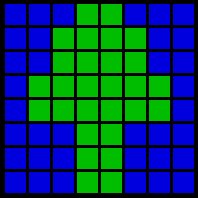Representing image through quadtree
Let’s say we divide the picture area into 4 sections. Those 4 sections are then further divided into 4 subsections. We continue this process, repeatedly dividing a square region by 4. We must impose a limit to the levels of division otherwise we could go on dividing the picture forever. Generally, this limit is imposed due to storage considerations or to limit processing time or due to the resolution of the output device. A pixel is the smallest subsection of the quad tree.
To summarize, a square or quadrant in the picture is either :
Now consider the following image :
The definition of a picture is a two-dimensional array, where the elements of the array are colored points .


Given Image in pixel form In Quad tree-form
Now when this image is represneted as quad tree it will look like :
 The quad tree of the above example picture. The quadrants are shown
The quad tree of the above example picture. The quadrants are shown
in counterclockwise order from the top-right quadrant. The root is the top node.
(The 2nd and 3rd quadrants are not shown.)
To summarize, a square or quadrant in the picture is either :
- entirely one color
- composed of 4 smaller sub-squares
Now consider the following image :
The definition of a picture is a two-dimensional array, where the elements of the array are colored points .


Given Image in pixel form In Quad tree-form
Now when this image is represneted as quad tree it will look like :
 The quad tree of the above example picture. The quadrants are shown
The quad tree of the above example picture. The quadrants are shownin counterclockwise order from the top-right quadrant. The root is the top node.
(The 2nd and 3rd quadrants are not shown.)
For matching procedure, color structure descriptor is first extracted from sample image and then matched with the descriptors associated to the images contained in the DB. Now here we can have a result image in certain range of tolerance according to two criterion : Quadtree Structure Similarity (QSS) and Quadtree Color Similarity(QCS). The main concept is that the difference in the structure of two quadtrees can be evaluated through the number of changes in the structure that need to be performed to make one of the quadtrees equivalent to the other. This process is called quadtree warping. Once the two quadtrees have the same structure, they are recursively navigated and the difference is computed between the colors of
the corresponding leaves. The final formula used for the similarity matching(SM) is the following:
weighting of the two metrics.
the corresponding leaves. The final formula used for the similarity matching(SM) is the following:
SM = A1*QSS + A2*QCS
where the constants A1 and A2 are determined empirically for normalization andweighting of the two metrics.


Sorry, I'm Brazilian and my English is 'very very bad'.
How I implement a quadtree in C++?
I need one implementation please. I nedd show a quadtree in a screen with you nodes coloring.
Thank you.
Posted by Grazi |
6:02 AM
Grazi |
6:02 AM